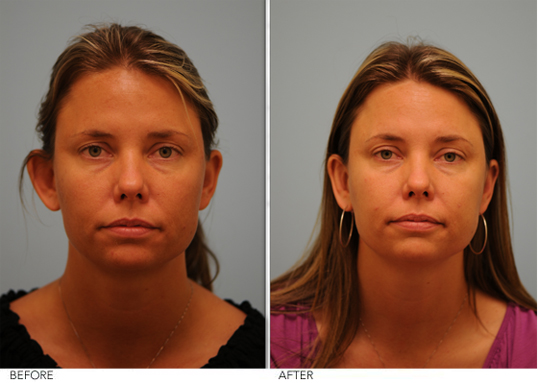Otoplasty: Looking at the Ear in Thirds
Otoplasty, or cosmetic ear pinning, is typically performed for individuals who were born with ears that stick out too far (see our otoplasty procedure page for more info). Although frequently performed in children, the majority of my patients nowadays are adults who simply decided later in life to have the procedure done. As a review, there are two types of protruding ears, cup ear deformities and lop ear deformities. Lop ear deformities are more common as an isolated problem and involve the absence of the antihelical fold causing the ear to protrude out. The antihelical fold, or antihelix, describes the fold in the ear that runs almost parallel to the outer fold of the ear known in turn as the helix. A cup ear deformity refers to excess of cartilage in the conchal bowl that causes the ear to stick out. The conchal bowl, or concha, describes the cartilage that is situated right near the ear canal and looks like a bowl. In addition, the lower third of the ear, known as the ear lobule, can also be protuberant. At times, this part of the ear can stick out after the rest of the ear has been brought back closer to the face. This blog article will describe how I evaluate the ear for the proper technique of ear pinning based on the ear pathology in each third of the ear.
Right sided cup/lop ear deformity and left sided lop ear deformity correction otoplasty
The upper third of the ear is affected by the absence of the antihelical fold, the so-called lop deformity. The middle third of the ear is affected principally by the presence of a cup deformity, i.e., an excess of conchal cartilage. The lower third of the ear may exhibit the aforementioned protuberance of the ear lobule that may also require reduction. This article will describe how I reduce each part of the ear and why. A good way to determine which problem you have is to gently pull back the upper, then middle, then lower third of the ear and see if there is an improvement in each area. If you have improvement that is noticeable in the upper third of the ear, then a lop ear correction may be warranted. If you have improvement in the middle third of the ear then you may need to have a cup ear correction. If you have a protuberant lobule OR if the lobule becomes protuberant after you pull back on the upper two-thirds of the ear, you might need to have a lobular setback. These are imprecise ways of reading what part of your ear is sticking out but may serve as helpful guides until you discuss your case with a qualified and experienced facial plastic surgeon.
Now, we will discuss exactly how I correct each of the three problems and why I have selected a particular method. The lop ear deformity requires the recreation of the antihelical fold, which I undertake with Mustardé sutures. These sutures are permanent but the ear can relax slightly over the first year after a procedure in some cases, and a patient should be aware of this possibility. It is rare that the ear would relax all the way back to beginning however. I do not prefer to cut out any antihelical cartilage but only score the backside of the cartilage because what I have found is that if the antihelix is cut the cut edge becomes visible over time and looks artificial.
The cup ear deformity is most commonly seen in combination with some degree of lop ear deformity and is rarely corrected in isolation. I have found that just tacking the concha back with sutures fails to address the problem, which is an excess of cartilage. When I perform a cup ear reduction, I remove about 1 to 5 mm of excess cartilage in the inner curvature of the concha so that there is a predictable and secure reduction of the conchal excess. There is rarely any relapse or relaxation because the cartilage is removed. Unlike a lop ear reduction, the cut ear cartilage should be difficult if not impossible to be seen because it is hidden inside the edge of the concha.
Finally, for lobular reductions, in the past I would cut out the excess of a structure known as the cauda helicis, which is the end piece of cartilage of the helix, as the lower third of the ear does not have cartilage and is soft. I also used to perform V to Y soft-tissue reductions of the lobule. Although these methods were somewhat effective, they were not reliable methods to reduce the lobule. I have now over the past few years changed over to securing the cauda helicis to the cartilage above which almost perfectly situates the lobule where I want it without risk of it migrating. As mentioned, sometimes the lobule does not warrant reduction and at other times it starts to stick out only after reducing the upper two thirds of the ear. In these cases lobular reduction creates the most balanced result for overall Otoplasty.
This article did not review exactly how much reduction should be undertaken to avoid so-called telephone or anti-telephone deformities, which to me is a matter of artistry, judgment, and experience. That is why it is imperative to find a facial plastic surgeon who routinely performs this procedure. Finally, this article does not discuss the myriad ways that ears can be deformed that I have also corrected such as a hanging helix or other excessive cartilage deformities that require sculpting and shaping. Nevertheless, hopefully, this article provides a clear overview of the basic types of ear deformities that would benefit from Otoplasty.
Follow the links to learn more about Dr Lam’s Otoplasty procedures, including before and after photos, videos, and FAQs, or call 972.312.8105 to schedule a consultation .

